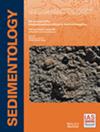没有陆地植物的曲流河流的沉积模型
IF 2.8
2区 地球科学
Q1 GEOLOGY
引用次数: 0
摘要
本文章由计算机程序翻译,如有差异,请以英文原文为准。
A depositional model for meandering rivers without land plants
The recognition of meandering rivers in Earth's prevegetation stratigraphic record is hindered by an absence of depositional models specifically tailored to unvegetated single‐channel rivers. As a result, their abundance on the early Earth is currently unknown. Here, sedimentological studies of two modern meandering river reaches with unvegetated banks were conducted. Both reaches are located in arid basins of Nevada, USA. Stratigraphy was analysed in conjunction with satellite imagery and high‐resolution topographic data to understand how channels and floodplains record past flow conditions. Analyses of point‐bar and channel‐fill deposits showed that lateral accretion sets are not heterolithic but, rather, composed of mixed sand and sand‐sized mud aggregates (clumps of clay and silt) interpreted to have formed through flocculation. Levées are present but subdued. Notably, downstream‐migrating outer‐bank‐attached bars are prominent architectural features that may be common in unvegetated meandering rivers in arid landscapes elsewhere. The identification of such depositional elements in the stratigraphic record may enhance recognition of ancient unvegetated meandering rivers and improve reconstructions of palaeohydrology on early Earth and Mars.
求助全文
通过发布文献求助,成功后即可免费获取论文全文。
去求助
来源期刊

Sedimentology
地学-地质学
CiteScore
8.20
自引率
11.40%
发文量
94
审稿时长
6-12 weeks
期刊介绍:
The international leader in its field, Sedimentology publishes ground-breaking research from across the spectrum of sedimentology, sedimentary geology and sedimentary geochemistry.
Areas covered include: experimental and theoretical grain transport; sediment fluxes; modern and ancient sedimentary environments; sequence stratigraphy sediment-organism interaction; palaeosoils; diagenesis; stable isotope geochemistry; environmental sedimentology
 求助内容:
求助内容: 应助结果提醒方式:
应助结果提醒方式:


